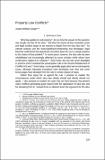Property Law Conflicts

View/
Author
Published Version
http://contentdm.washburnlaw.edu/cdm/ref/collection/wlj/id/6477Metadata
Show full item recordCitation
Joseph William Singer, Property Law Conflicts, 54 Washburn L. J. 139 (2014).Abstract
What law applies to real property? At one time the answer to this question was simple: the law of the situs. But then the choice-of-law revolution came and legal scholars began to see reasons to depart from the situs law rule. As interest analysis and the most-significant-relationship test developed, legal theorists undermined the logical and normative basis for such a simple solution to the choice-of-law problem. In recent years, however, the situs rule has been rehabilitated and increasingly defended by some scholars while others have continued to subject it to criticism. And in fact, the rule was never dislodged in practice and it remained the presumptive rule in the Second Restatement of Conflict of Laws. Even today, courts generally apply situs law to real property issues, although important exceptions have developed over time and some brave judges have deviated from the rule in certain classes of cases.Rather than argue for or against the rule, this article explains the difference between the false conflicts cases where only one state has a legitimate interest in applying its law and the true conflicts cases where two (or more) states have such interests. That analysis shows cases under which situs law clearly should and clearly should not apply, as well as the true conflict cases that are hard because they present value conflicts generating good reasons both for application of situs law and for deviating from it. Those hard cases are of four types: (a) conflicts between situs law and the law of the domicile of one of the parties; (b) conflicts between situs law and the place where a contractual relationship is centered; (c) nuisance-type cases where the conduct is in one state and the injury is in another; and (d) the special case of federal Indian law which involves the paradoxical case of overlapping situses. The article concludes by addressing the renvoi problem. Real property law has traditionally required application of renvoi for issues involving title to real property. This article explains the reasons why that is so and why those reasons are less powerful than we may have thought.
Other Sources
http://ssrn.com/abstract=2553918Terms of Use
This article is made available under the terms and conditions applicable to Other Posted Material, as set forth at http://nrs.harvard.edu/urn-3:HUL.InstRepos:dash.current.terms-of-use#LAACitable link to this page
http://nrs.harvard.edu/urn-3:HUL.InstRepos:34816657
Collections
- HLS Scholarly Articles [1913]
Contact administrator regarding this item (to report mistakes or request changes)


